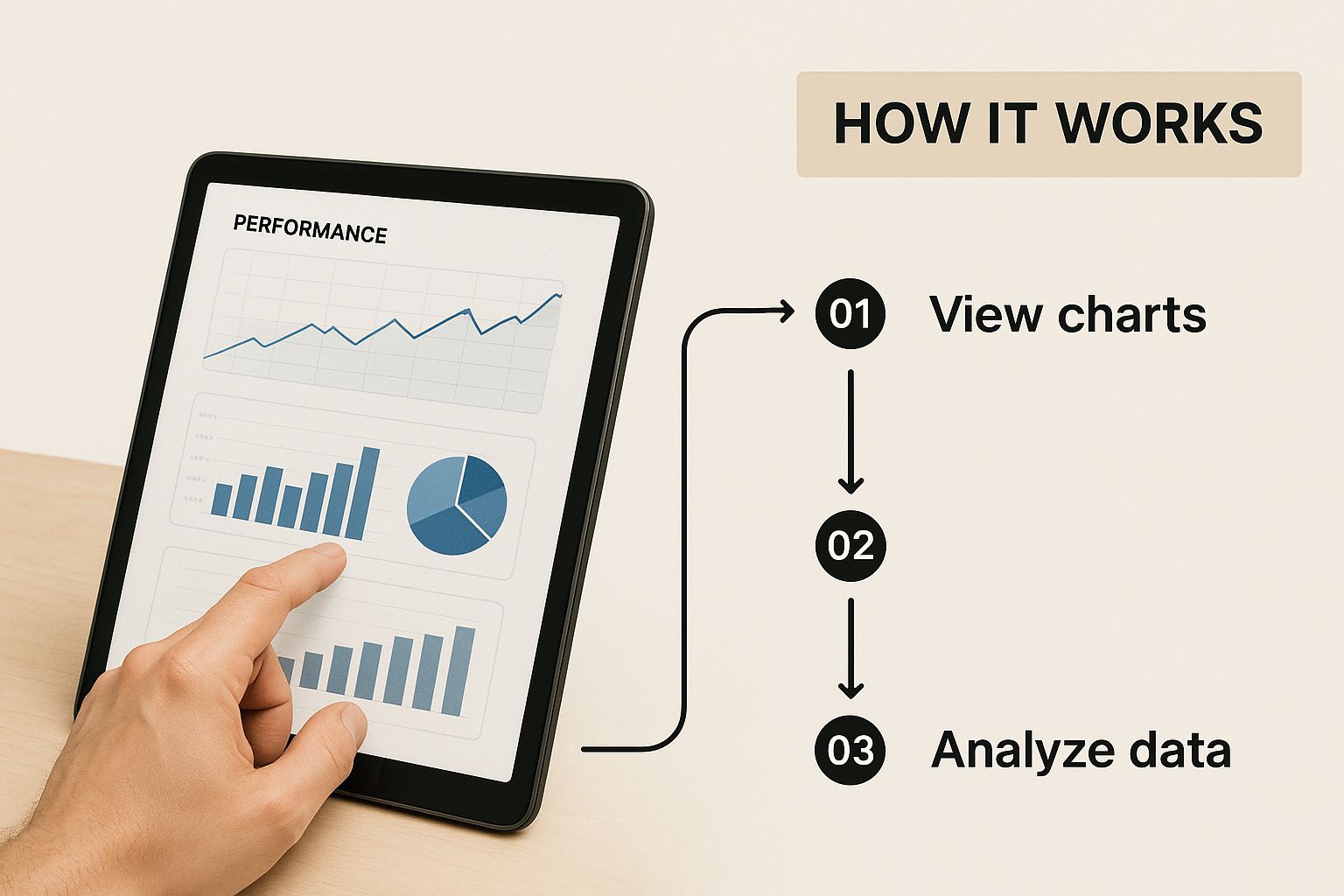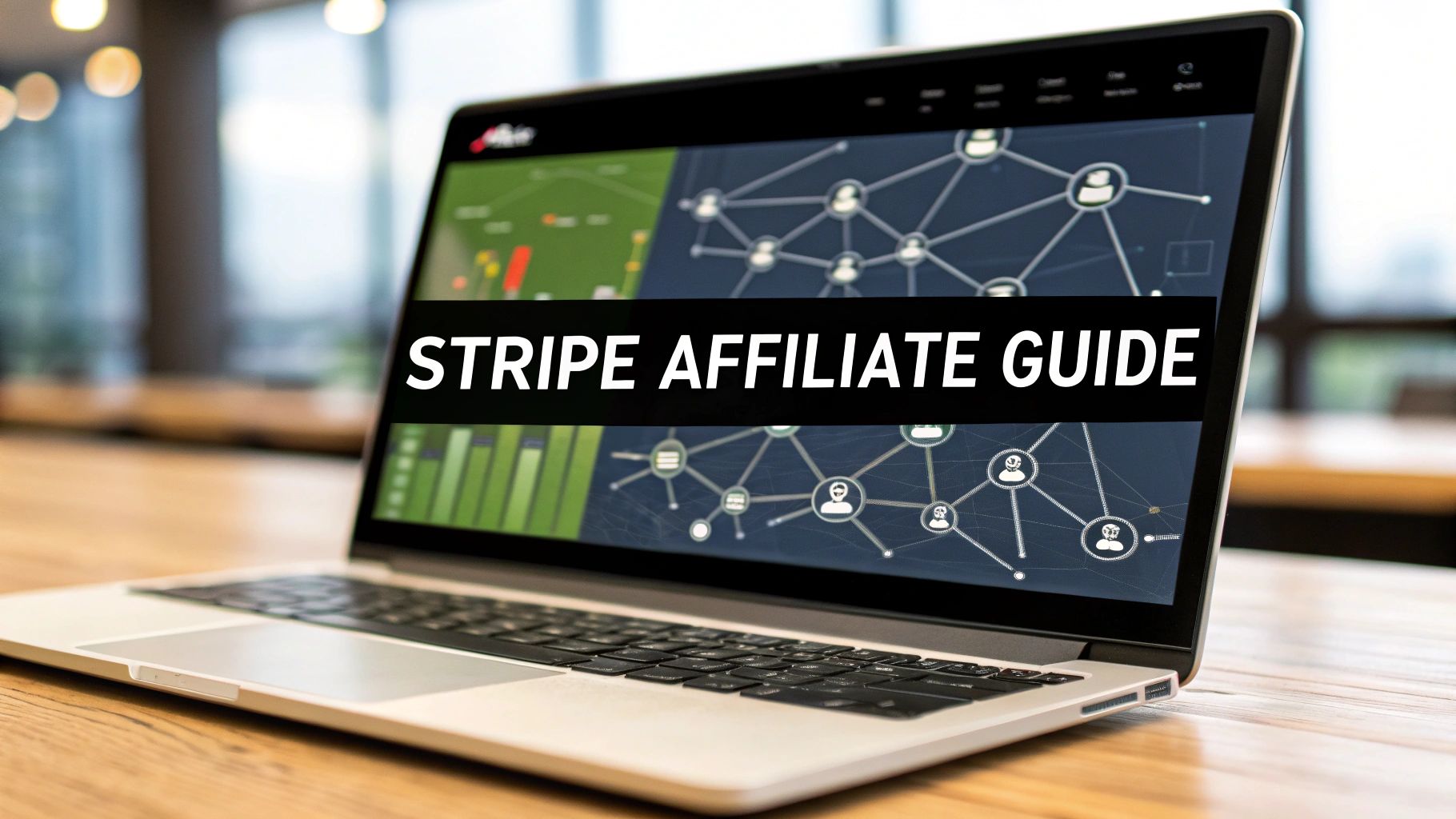Think of the Stripe affiliate program less like a typical affiliate deal with coupon codes and more like a sophisticated B2B referral network. It’s a strategic partnership designed for developers, agencies, and software companies who can bring new, high-quality businesses into Stripe's ecosystem. You’re not just sharing a link; you’re recommending a foundational piece of a company's financial tech stack.
How the Stripe Affiliate Program Works
At its heart, the program is simple: you introduce businesses to Stripe, and when they sign up and start processing payments, you get paid. It's a structured way for Stripe to grow through trusted, expert recommendations from people who are already building things on the internet.
This partner-centric approach has been a massive engine for Stripe's growth. By early 2025, Stripe was operating in 47 countries, powering over 1.2 million live websites, and had carved out a 19.45% share of the global payment processing market. A huge part of that success comes from this network of partners driving adoption. You can dig into all the numbers and see the full statistics on HelpLama.com.
To give you a clearer picture, here’s a quick breakdown of the program's key elements.
Stripe Affiliate Program At a Glance
| Aspect | Description |
|---|---|
| Who It's For | Developers, agencies, and SaaS platforms that integrate or recommend payment solutions. |
| What You Promote | Stripe's core payment processing services and broader financial infrastructure. |
| How You Earn | Commissions are paid when a referred business signs up and starts actively processing payments. |
This isn't about one-off sales; it's about fostering long-term, valuable customer relationships for Stripe.
Who Is This Program For?
Stripe is very specific about who they want as partners. This isn't for a casual blogger hoping to drop a banner ad on their site. It’s built for professionals who are in a position to make a credible recommendation.
It's a perfect fit for:
- SaaS Companies: If your software needs a payment solution for its users, you can refer them directly to Stripe.
- Developers & Agencies: When you build an e-commerce store or a custom app for a client, you can set them up with Stripe.
- Platform Builders: Think marketplaces or multi-vendor platforms. You can onboard your users onto Stripe to handle their payments.
You can see this focus on their official partner page, which is all about helping partners build their own revenue by working with Stripe.
The language—"earn recurring revenue" and "access resources"—makes it clear this is a serious partnership, not just a link-sharing scheme.
The Core Mechanics
So how does it work in practice? Once you’re approved, you get a unique referral link. When a business clicks that link, signs up for Stripe, and starts processing real transactions, you earn a commission. The whole system runs on trust.
The real value comes from your ability to influence a business decision. You aren't just selling a product; you are recommending a core piece of financial infrastructure for another company.
This is the key difference. A successful Stripe affiliate isn't just pointing to a service; they're often actively integrating it into a client's business. That makes the referral incredibly sticky and valuable, which is why the program is structured as a true B2B relationship.
Understanding the Stripe Partner Ecosystem

When people talk about a "Stripe affiliate program," they often picture a single, straightforward deal. But the reality is a lot bigger. What we’re really talking about is one slice of a much larger universe called the Stripe Partner Ecosystem. Getting this distinction right from the start is key to figuring out where your business fits in.
Think of it this way: The Affiliate Program is like being a finder for a real estate agent. Your job is simple and direct: you bring in a qualified buyer, and when they close on a house, you get a one-time fee. It’s a clean, transactional relationship focused on generating new leads.
The wider Partner Network, on the other hand, is more like being a general contractor who builds entire housing developments. You’re not just making an introduction; you're building on the platform, creating new value, and establishing a deep, ongoing relationship. This is about collaboration, not just referrals.
Affiliates Versus Partners
So, what's the real difference? It all boils down to how deeply you integrate with Stripe and the kind of relationship you want to build. Both roles help grow the Stripe user base, but they serve very different functions and come with distinct rewards.
Stripe Affiliate Program:
- Focus: Your primary goal is to refer new businesses to sign up for a Stripe account.
- Reward: You get a one-time commission for every referral that becomes an active, paying Stripe customer.
- Ideal For: Freelancers, agencies, and consultants who recommend Stripe to clients as part of a larger project, like building a website or setting up an e-commerce store.
Stripe Partner Network:
- Focus: This is for those building apps, integrations, or specialized services that are deeply woven into the Stripe platform.
- Reward: The benefits go way beyond a simple commission. We’re talking about revenue sharing, joint marketing campaigns, and access to dedicated technical support.
- Ideal For: SaaS platforms using Stripe for their own customers, tech companies with verified apps in the Stripe marketplace, and certified implementation experts.
The affiliate path is about making a valuable introduction. The partner path is about building a business that runs on Stripe’s rails. The right choice depends entirely on your business model and long-term goals.
Choosing Your Path
Deciding which route to take isn't a matter of which one is "better." It's about what makes sense for you.
If you regularly build websites for clients and recommend Stripe as the best payment solution, the affiliate program is a no-brainer. It’s a simple, hassle-free way to earn a little extra for a recommendation you were already making.
But if you're developing a software platform that needs to manage complex payment flows for hundreds or thousands of your own users, then joining the Partner Network is the clear choice. The resources, support, and financial incentives are built for that kind of scale. Understanding how to find affiliates and partners who align with your own strategy is a crucial skill, and it starts with knowing where you fit into the ecosystem first.
Integrating and Tracking Affiliate Referrals
Turning your affiliate program idea into a real, money-making system comes down to the technical details. This is where we get our hands dirty and build the engine that powers it all. We need to tackle two key things: creating unique links for your partners and tracking their performance without any mistakes. The goal is to ditch the manual spreadsheets and build a setup that just works.
It all starts the moment you bring a new affiliate on board. They need their own unique referral link or a special code. Think of this as their digital fingerprint—it’s how your system knows exactly who sent a new customer to your site.
When someone clicks that link, your website needs to grab that affiliate's ID and store it, usually in a browser cookie. This cookie might last for 30 or 60 days, ensuring that even if the customer leaves and comes back later to buy, the original affiliate still gets credit.
That first step is crucial, but the real magic happens when that customer actually pays for something. This is where Stripe’s developer tools shine, specifically Stripe Connect and Webhooks.
Setting Up Automated Tracking
So, what are Webhooks? Imagine them as a direct notification line from Stripe to your app. Instead of you constantly pinging Stripe and asking, "Did anyone buy anything yet?", Webhooks send you an instant alert the second a key event happens.
This flow is what makes a seamless, automated tracking system possible.

As you can see, a customer's action triggers an event in Stripe. Stripe then sends a webhook to your system, which does the work of connecting the sale to the right affiliate and calculating their commission.
To build a solid tracking system, you’ll need to "listen" for a few specific events from Stripe. Here are the most important ones:
customer.created: This fires off the moment a new customer is created in Stripe. Your system's job is to check if this new customer has an affiliate ID attached to them from that initial cookie.charge.succeeded: This is the big one. It’s the signal that a payment went through successfully. When your app gets this webhook, it can confirm the purchase and officially credit the affiliate.invoice.payment_succeeded: If you run a subscription business, this event is your best friend. It tells you every single time a recurring payment is processed, which is essential for paying out ongoing commissions.
By combining referral cookies with Stripe Webhooks, you create a perfect, closed-loop system. The cookie points to the referrer, and the webhook confirms the sale. All the guesswork is gone.
This automated setup is the foundation of any affiliate program that’s built to scale. It guarantees every referral is tracked accurately, which builds trust with your partners. More importantly, it saves you from the administrative headache of trying to track everything by hand. With this technical framework in place, you can grow your program confidently, knowing every sale is accounted for.
Automating Affiliate Payouts with Stripe

Alright, so your tracking system is humming along and correctly identifying referrals. That’s a huge win. The next big piece of the puzzle is paying your affiliates. This isn't just an administrative task; it's the foundation of trust in your program. If payments are late or wrong, you'll lose good partners fast.
Manually crunching numbers and sending out payments one by one might work when you have a handful of affiliates, but it quickly becomes a nightmare as you scale. This is where Stripe really shines.
Instead of tacking on payouts as a manual chore, you can weave an automated system right into your existing payment flow. This ensures every affiliate gets paid the right amount, right on time, without you lifting a finger for each transaction.
First things first, you need to decide on your commission structure. This is the rulebook that determines how partners get rewarded for their efforts.
- Percentage-Based: Your affiliate earns a slice of the pie, like 20% of every sale they send your way. This is a powerful motivator for partners to push for higher-value sales.
- Fixed Reward: You pay a flat fee for a specific action, say $50 for every new paying customer. This model gives you predictable costs and your affiliates a crystal-clear goal.
Once you’ve got your rules set, you can lean on Stripe’s powerful infrastructure to handle the rest.
Creating a Seamless Payout System
The magic behind automated payouts is a tool called Stripe Connect. Think of it as a hub that lets you create a financial network between your business and all your affiliates. Each partner gets set up as a "connected account" that links directly to your main Stripe account.
This setup transforms what used to be a messy, manual process into a clean, programmatic one.
With Stripe Connect, you’re not just sending money; you're creating a direct, automated link to your affiliates' bank accounts. This eliminates the need for manual invoices, wire transfers, or third-party payment services. It’s a core function of a scalable Stripe affiliate program.
Here's how it works in practice: when a customer you know was referred by an affiliate makes a purchase, your system instantly calculates the commission. Then, using the Stripe API, it can trigger a transfer directly from your Stripe balance into that affiliate's connected account.
This programmatic approach is what separates a professional, scalable program from one that feels like a side hobby. The ability to automatically calculate commissions and fire off payouts is a game-changer. It slashes human error and frees up an incredible amount of time.
If you’re ready to really dig into the mechanics, our guide on how to automate affiliate marketing explores more advanced strategies. By building this financial engine, you create a program that can grow from ten affiliates to ten thousand without your administrative workload exploding.
Weighing the Benefits and Drawbacks
https://www.youtube.com/embed/8L--CXrwVSI
Choosing to build your affiliate program on top of Stripe's infrastructure is a big decision. It comes with some serious perks, but also a few potential headaches you need to be aware of.
On the one hand, you're tying your program to one of the most powerful and respected names in online payments. That association alone gives your payout system instant credibility and creates a smooth, professional experience for your partners.
But on the other hand, this isn't a simple "plug-and-play" affiliate platform. A custom Stripe affiliate program demands a real investment in technical resources to get it built and keep it running smoothly. Let's dig into the pros and cons so you can figure out if it's the right move for you.
The Upside of Building on Stripe
The single biggest reason to go with Stripe is its world-class payment engine. You’re tapping into a system that handles global payouts like it’s nothing, which means you can recruit and pay affiliates almost anywhere on the planet. For any business with an eye on international growth, that's a game-changer.
Then there's the trust factor. Affiliates are far more likely to join and promote a program when they feel confident they'll actually get paid on time, every time. The Stripe brand is a powerful signal that you’re a serious, professional operation. Stripe’s own success proves this; in 2024, it processed over $1.4 trillion globally, a staggering 40% increase from its $1 trillion milestone in 2023, a jump powered in part by its own partner network.
The Challenges and Costs
The main hurdle is the development work. Unlike off-the-shelf affiliate software, using Stripe’s APIs means you need a developer (or a development team) to actually build the system. They’ll have to code the tracking logic, the commission rules, and the automated payout flows. That's a direct upfront investment of both time and money.
You also have to remember Stripe's transaction fees. While you get a world-class system, you’re still paying for every dollar that moves through it. It's a good idea to check out a detailed payment processing fees comparison to see how Stripe's costs stack up against other options.
Ultimately, the decision comes down to a classic trade-off: control vs. convenience. Stripe gives you incredible control to build the exact system you want, but you sacrifice the out-of-the-box simplicity of an all-in-one affiliate platform.
To make it even clearer, let's look at a side-by-side comparison.
Stripe Affiliate Program Pros vs Cons
This table breaks down the key advantages you gain and the challenges you'll face when using Stripe's ecosystem to manage your affiliate program.
| Pros | Cons |
|---|---|
| Global Reach: Easily pay affiliates in dozens of countries with multiple currencies. | Developer Dependent: Requires technical expertise to build and maintain the system. |
| Brand Credibility: Leveraging the Stripe name builds immediate trust with partners. | Complexity: Setting up tracking and custom logic can be complicated. |
| Automation Power: Stripe Connect and APIs allow for fully automated payouts at scale. | Transaction Fees: You must factor Stripe's processing fees into your program's costs. |
| Ultimate Flexibility: You can build a program perfectly tailored to your business needs. | No Built-in Dashboard: You must create your own interface for affiliates to see stats. |
In the end, the right choice really depends on your company’s technical skills, budget, and where you are in your business journey. For a tech-first company with developers on hand, the power and flexibility of a custom Stripe solution are tough to beat. For everyone else, a more turnkey platform might be a smarter place to start.
Best Practices for a Successful Program
Getting the technical side of your Stripe affiliate program right is just the starting line. The real work—and the real growth—comes from how you manage it day-to-day. Launching the program isn't the finish line; it's just the beginning of building a powerful new revenue channel for your business.
It all starts with finding the right partners. Don't just open the floodgates and accept anyone who applies. You need to be proactive and seek out affiliates whose audience and brand are a natural fit for what you sell. A small handful of genuinely aligned partners will always drive better results than a massive, unengaged army of affiliates.
For partners in specialized industries like financial technology, deep-niche expertise is a game-changer. Understanding specific tactics, like effective fintech SEO strategies, can make a world of difference in their ability to drive qualified traffic.
Equip Your Partners for Success
Once you’ve recruited the right people, your job is to set them up to win. This means giving them more than just a lonely referral link.
- Provide High-Quality Assets: Build a go-to library of marketing materials. Think pre-approved ad banners, social media graphics, email templates, and product fact sheets. This not only makes their job easier but also keeps your branding consistent.
- Offer Clear Communication: Keep the lines of communication wide open. Send out regular updates on new product features, upcoming promotions, or even just tips on what’s working best for other partners.
- Design Motivating Commissions: Your commission structure has to be both competitive and dead simple to understand. Whether you choose a percentage of each sale or a flat fee per referral, make sure it’s a fair reward for the value they’re creating.
A reliable partner dashboard is non-negotiable. Your affiliates need to see their clicks, conversions, and commissions in real-time. This visibility is what keeps them motivated and helps them fine-tune their approach. Trust is built on transparency.
Affiliate marketing isn't just a side hustle; it's a massive, growing part of the global economy. The industry was projected to jump from $27.8 billion in 2024 to a staggering $48 billion by 2027. This explosive growth shows just how much potential is on the table.
Ultimately, running a great affiliate program is a continuous cycle of finding good people, giving them what they need to succeed, and constantly tweaking your strategy. For a much deeper look into the day-to-day operations, check out our complete guide on how to effectively manage your affiliate program.
Got Questions? We’ve Got Answers
When you start digging into the idea of a Stripe affiliate program, a few key questions tend to pop up again and again. Let's tackle them head-on to clear up any confusion and help you figure out the best approach for your business.
Does Stripe Actually Have an Official Affiliate Program?
This is the big one. The short answer is yes, but it’s probably not what you're imagining.
Stripe doesn't have a simple, sign-up-and-get-a-link affiliate program for referring new merchants. Instead, their program is built into the broader Stripe Partner Ecosystem. It’s designed for agencies, platform developers, and consultants who actively integrate Stripe into their clients' projects, not for traditional affiliate marketers.
How Much Technical Skill Do I Really Need?
If you plan to build a custom affiliate program using Stripe's APIs, you'll need a serious technical background. This isn't a plug-and-play solution.
Your team needs to be comfortable with backend development to manage API calls, process webhooks for real-time tracking, and handle all the data securely. Think of it as building a small application from the ground up, not just flipping a switch.
For businesses without a dedicated developer on standby, this technical hurdle is often the biggest dealbreaker. The incredible power of Stripe’s tools is there for the taking, but it comes with the responsibility of building and maintaining the entire system yourself.
Can I Run a Program Without Using Stripe Connect?
You technically could, but it would be a logistical nightmare. You'd be stuck tracking every referral manually in a spreadsheet and then sending out payments one by one through another service.
This completely sidesteps the whole reason for using Stripe in the first place—its powerful automation. Stripe Connect is the engine that handles the payouts automatically. Without it, you don't have a scalable, efficient affiliate program; you have a manual accounting headache.
Ready to launch a powerful, native affiliate program for your SaaS without the technical overhead? Refgrow lets you set up a fully customizable dashboard inside your app with just one line of code. Start growing your business with zero transaction fees at https://refgrow.com.

